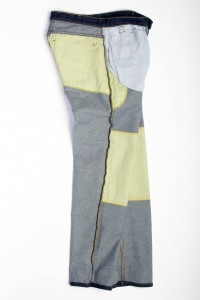By Bud Wilkinson of RIDE-CT.com
There probably isn’t a motorcyclist who doesn’t ride in blue jeans – if not most of the time, at least occasionally. Some  riders wear leather chaps over their jeans while others wear non-denim riding pants packed with armor, but plain ol’ jeans are always the fall-back attire. Jeans are as American as Harley-Davidson, except that unlike Harleys not many jeans are made on home turf anymore.
riders wear leather chaps over their jeans while others wear non-denim riding pants packed with armor, but plain ol’ jeans are always the fall-back attire. Jeans are as American as Harley-Davidson, except that unlike Harleys not many jeans are made on home turf anymore.
The problem with today’s jeans is that they are grossly inferior to ones made years ago. No matter what brand I buy, the right corner of the left rear pocket (where my wallet gets stowed) always rips prematurely. I’ve gone through Levis, Wranglers, Carhartts and Eddie Bauers trying to find a durable brand without success. I’m now trying Cabela’s house brand.
For the heck of it, I went to the laundry room in my basement to check the labels on some jeans that have been discarded because of shoddy quality. The Levis were made in Colombia and El Salvador. The Wranglers came from Nicaragua. The Carhartts and Eddie Bauers came from Mexico. The jeans from Cabela’s that I’m currently wearing say “Made in Swaziland.” They’re too new to pass judgment on – yet.
On the way back to my second floor home office, I stopped in my bedroom and pulled out the black jeans that I usually wear when riding. I’ve had them for several years. They’re Draggin’ Jeans, Kevlar-lined and able to accept knee armor. While they’re fraying at bit at the bottom because I ordered them too long, the stitching and fabric around the left rear pocket are intact despite high mileage. I looked and was pleasantly surprised to find the words “Made in USA” on the inside label.
Draggin’ Jeans were developed 15 years ago by Fast Company of Hickory, N.C. “When we started making the jeans, we vowed that we would always stay in the U.S.,” said Fast Company’s Karla Cornett, who answered when I later phoned. “Most people want products made in the U.S.”
For competitive reasons, Cornett declined to specify the location of the factory where Draggin Jeans are produced. “There’s only a handful of manufacturers, which is part of the reason we don’t give out that information,” she explained. “We’ve never had our products made outside of the U.S. We don’t keep it in the U.S. because of quality, but because it’s our home. It keeps our economy going.”
Draggin’ Jeans aren’t cheap. Available in blue or black, they start at $99.95. But with Kevlar panels inside, designed to prevent road rash in the case of a crash, they’re worth it. And I’ll attest that they hold up to normal use. Draggin’ Jeans can be found online at dragginjeans.com. “We’re using the thickest denim to help with the quality. The thickest denim possible,” said Cornett, reporting that the company’s jeans use 14.5-ounce denim.
Another company offering U.S.-made motorcycle jeans is Diamond Gusset Jeans of Bon Aqua, Tenn. The company’s  “Defender” jeans in blue or black are lined with Kevlar as well and sell for $115.95. But they have features that the Draggin’ Jeans don’t – a gusset in the crotch to allow for more freedom of movement and an adjustable tab at the bottom of each leg that can be pulled tight to prevent wind from going up your legs when riding.
“Defender” jeans in blue or black are lined with Kevlar as well and sell for $115.95. But they have features that the Draggin’ Jeans don’t – a gusset in the crotch to allow for more freedom of movement and an adjustable tab at the bottom of each leg that can be pulled tight to prevent wind from going up your legs when riding.
The president of Diamond Gusset is David Hall, who co-founded the company 25 years ago. A self-described “patriot,” Hall staunchly believes in American products and American workmanship. The rivets and zippers for his jeans come from Kentucky, the cotton from Texas, the thread from South Carolina and the pocketing from Alabama. The woven labels are made in New York and the printing is done in Tennessee. Assembly happens in Blue Ridge, Ga. in a small plant that used to be a satellite factory for Levis, before production moved overseas.
“The way I see it,” said Hall, “is a small company can make a difference. I’m convinced that our unemployment rate wouldn’t be where it is if more products were American-made. I don’t know how we can continue to have a middle class without manufacturing.” Hall is convinced that a small company can have an impact. In his case, he impacts his suppliers. “I’m helping them make payroll,” he said.
Like Draggin’ Jeans, Diamond Gusset use 14.5-ounce denim. “We use a coarse-weave denim, heavyweight, rugged denim that you would have seen in Levis back in the ‘70s and early ‘80s. That holds up well and fades out. Most of the denim used today off-shore is 11, maybe 12 ounces,” he reported, promising that “you’ll never get a hole in our pockets.”
Hall noted that quality control in faraway lands also isn’t what it is with Diamond Gusset. “We set high standards. We have an inspection process three different times on our products,” he said. “I don’t think the attention to detail is taking place on products that are being made off-shore.”
Unlike Draggin’ Jeans, Diamond Gusset, online at gussetclothing.com, also makes casual jeans in several styles. The price starts at $49.95. Perhaps swayed by Hall’s enthusiasm, I ordered a pair on Thursday.
Hall also revealed that Diamond Gusset has a new motorcycle jean on the way this summer called the Defender II that will incorporate not only Kevlar, but armor in the knees, hips, seat and elsewhere, even in the shins. They will probably come out in July after testing of prototypes. Yes, I immediately volunteered to help the company in real-world testing. Hall said he might take me up on the offer.
Seeing as how I have numerous “work jeans” that have demoted to that status after getting the ripped rear pocket repaired, I’m pessimistic of ever finding a pair of quality “imported” jeans that will last. I may be broad in mid-section but my backside isn’t super-sized. It’s not me, rather inferior merchandise. Given the short shelf life of jeans made elsewhere, I’m convinced that money will be actually saved in the long run by paying a little more upfront.
 Ride CT & Ride New England Serving New England, NYC and The Hudson Valley!
Ride CT & Ride New England Serving New England, NYC and The Hudson Valley!

